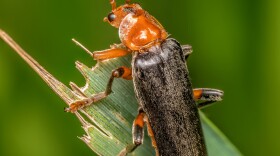It’s happened throughout history many times. You devote your life to working on a project that someone else gets all the credit for. For example, Thomas Edison is known as the inventor of the light bulb, but evidence shows that other inventors came up with the idea first. It happens in the insect world too. While dung beetles capture the public’s attention as the main decomposers of all sorts of animal poop, flies (like the lesser-known Golden Dung Fly) play an equally (if not more important) role in getting rid of the waste of large mammals, like horses, cattle, bison, deer, and more. The Golden Dung Fly is found throughout the cooler, temperate regions of the Northern Hemisphere. Because of its desire for dung, it’s more commonly found in agricultural areas with a seemingly endless supply. Their lifecycle revolves around dung. Adults use their sensitive antennae to sniff for fresh poop, flying against the wind to find a pile that’s just right. The adults prey mainly on smaller insects, so they don’t play a direct role in the decomposition of dung. Their kids do all the work. Females lay their eggs on the surface of the dung, and within two days the larvae emerge with a never-ending appetite. With up to four overlapping generations each year, they are essential in decomposing what otherwise would be an accumulating mess. While the females are pretty dull in color, the appearance of the males might not exactly be what you’d expect from an animal that spends its entire life in and around animal poop. They are stunning – bright golden-yellow with orange-yellow fur on their front legs.
Golden Dung Fly





